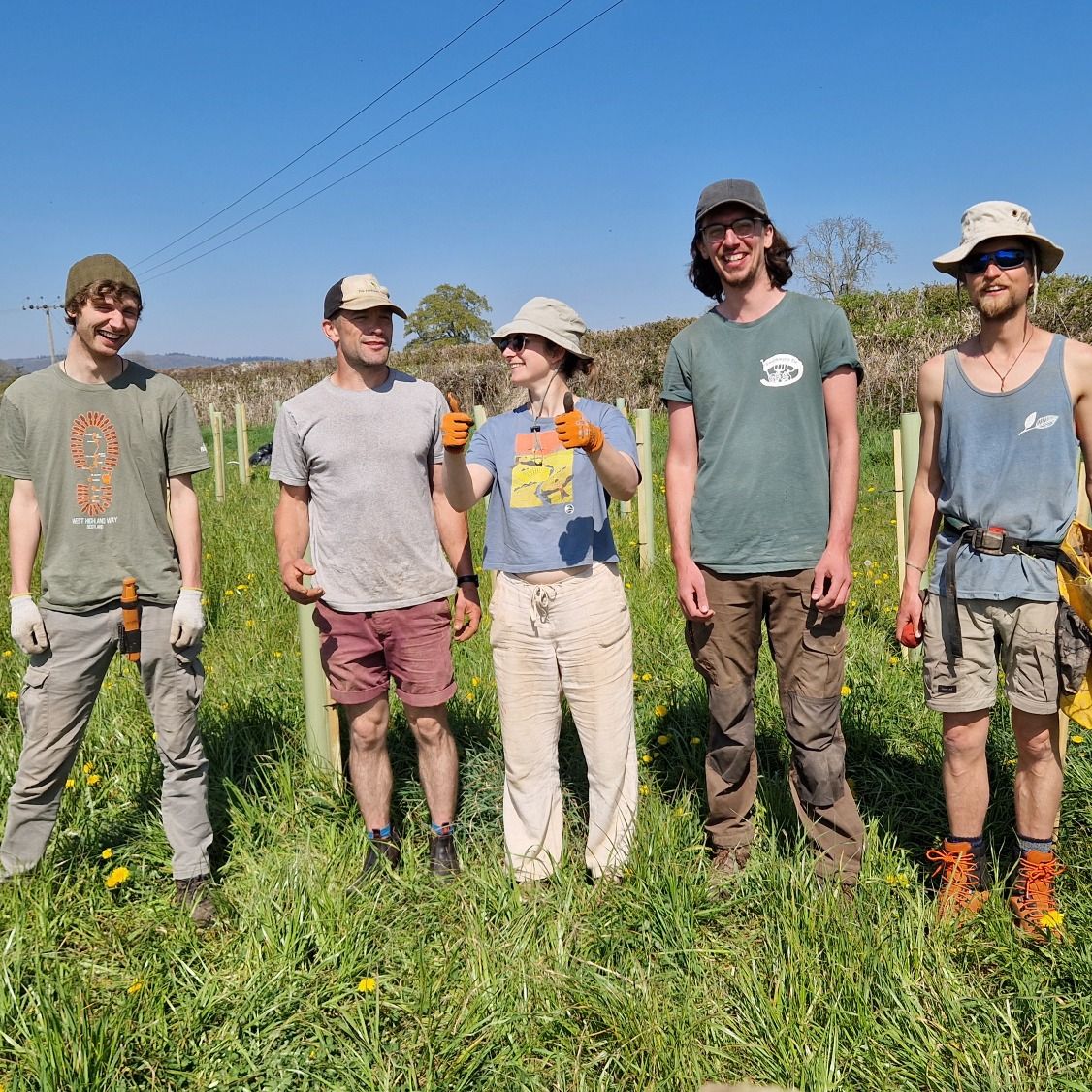Reasons to be cheerful (about coppicing)
Managing woods for resilience and biodiversity
Where does the time go? It feels like a few weeks since the winter cutting season, but now we’re on our way to summer and thinking about the next one. And next winter, we will be able to put our new electric saws through their paces for the full season, whoop!
Other things we got up to in the last months included a whole raft of planting (great to work with you on Severn Treescapes, Herefordshire Wildlife Trust!), and rewarding coppice restoration at some interesting new sites. It was brilliant to have a team of new recruits, as well - all graduates of Black Mountain College. Ewan, Bryony, Charlie and Bill (pictured with team leader Simon), and Gwyn (obviously not in on that sunny day!) - thanks for all your hard work this year.
We’re blessed to have a variety of places to work in, from Leigh Woods in Bristol, to the banks of the Wye, nature reserve Margaret's Wood tucked up in the hills beyond, and northwards, at a historic estate in Herefordshire - although as we’re on our travels it’s nailbiting seeing both newly planted and established trees cling on in the dry weather...

Building resilience against drought
Did you know, spells of drought can affect trees way down the line? Growth rings will show years when they were affected and had to put their resources into just staying alive – and eventually those tough years can take their toll. As you’d expect, drought-stressed trees are particularly susceptible to insect and pathogen attacks [1].
There are ways to help established woodlands be more resilient to drought. A recent review of scientific literature concluded that thinning – a forest management technique where some trees are removed – can help resilience against this and other stressors [2]. It stands to reason that reducing the number of trees in an area will decrease competition for water, of course. Coupled with the benefits for biodiversity of opening up the forest floor, so a range of light-loving species can also thrive, it’s yet more evidence that managing woodlands is a positive thing to do, especially in the face of climate change.
Intensive thinning, spiders and beetles
Speaking of which, some Czech researchers have looked into how biodiversity recovers when neglected coppice is restored [3]. Noting that abandonment of traditional management is among the major causes of the loss of temperate forest biodiversity, they applied different levels of thinning in an abandoned coppice to examine the response of plants, ants, ground beetles and spider communities. One of their interesting findings was that beetle and spider species richness was only significantly increased in the most intensively thinned areas. Importantly, they recommend keeping intensive thinning or coppicing away from forest edges, to reduce the chance of invasive species taking hold.
Compaction changes ground flora
One other piece of research we noticed lately was a study conducted in northern France on the effect of harvesters and heavy machinery on forest vegetation [4]. Compaction caused by vehicles and machinery was found to be the “main driver of understorey vegetation change over 30 years” in 206 plots surveyed in 1990 and 2022.
Which plants like to make their home in wheel tracks? Skid trails facilitated the establishment of pioneer “invader” species, say the researchers, who found more non-forest, non-native plants and wetland species in the 2022 survey. Sadly, the few species which decreased between surveys were ancient woodlanders such as Luzula pilosa (hairy woodrush) and Convallaria majalis (lily of the valley). Operations planning should better account for these impacts on vegetation, say the researchers.
It’s a delicate one to navigate, because we need to harvest timber but also look after our ancient woodland species. Wye Coppice doesn’t have to worry much about causing compaction, because we only carry out manual felling. We’re passionate about keeping our negative impacts to a minimum – hence adopting battery-powered equipment this year. Our workers love their woodland plants and understand the importance of (sensitively) controlling invasives.
If you have an undermanaged woodland, neglected coppice or even one in active rotation, we would love to work with you to make it thrive, so please get in touch to discuss!
References
1. Jactel, H., Petit, J., Desprez‐Loustau, M. L., Delzon, S., Piou, D., Battisti, A., & Koricheva, J. (2012). Drought effects on damage by forest insects and pathogens: a meta‐analysis. Global Change Biology, 18(1), 267-276.
2. Chagnon, C., Dumont, S., Morin-Bernard, A., Jactel, H., Achim, A., & Moreau, G. (2025). Potential of thinning to increase forest resilience and resistance to drought, pest, windstorm and fire: A meta-analysis. Forest Ecology and Management, 590, 122788.
3. Šipoš, J., Košulič, O., Chudomelová, M., Dorňák, O., & Hédl, R. (2025). Ecological mechanisms of canopy thinning: Insights into biodiversity recovery in neglected coppice. Biological Conservation, 303, 111003.
4. Vennin, S., Montpied, P., Behr, P., Thimonier, A., & Dupouey, J. L. (2025). Mechanisation of forest operations drives long-term changes in plant communities. Forest Ecology and Management, 585, 122562.
